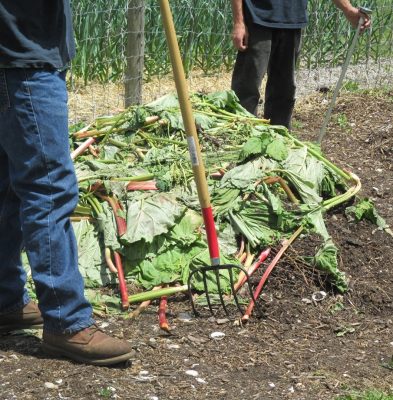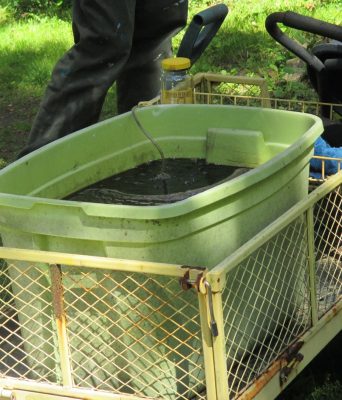In an effort to improve soil and produce healthy fruit and vegetable plants, many home gardeners are turning to natural/organic sources of fertility. This can include the use of compost, compost teas, and manures. These amendments are often quite variable in age and composition. Manures may be fresh and raw, or composted and well decomposed. Compost teas can be made from leaf -or manure- based composts. Backyard compost piles often do not heat up to 130 to 150 degrees F so typically pathogens are not controlled in home piles.
Compost is the natural breakdown product of leaves, stems, manures and other organic materials - and, a potential source of the pathogens that cause foodborne illness. Salmonella, E. coli O157:H7, and other bacteria, viruses and parasites can live happily in a pile of unmanaged compost. One certainly does not want to add these microbes to the soil that is growing your salad! However, proper composting will kill pathogens and weed seeds, and improve the quality and safety of your compost.
Using Manure or Manure-Based Composts
Manure is an excellent fertilizer and soil conditioner. But, applying fresh manure to your fruit or vegetable garden does not really make food safety sense. Even aged manure can have E. coli present. It is least risky, if manure is your soil amendment of choice, to use commercially composted manure. Purchase from a reputable company that follows practices that can insure that pathogens are destroyed in the process.
Backyard composting of manure is more risky. It may be difficult, partly because of smaller sized piles, to achieve pathogen-killing temperatures. The process requires careful management including regular and adequate mixing of materials, and also temperature monitoring with a long stemmed compost thermometer. The temperature must reach 130 to 140 degrees F for at least two five-day heating cycles. After composting, the compost must “cure” for two to four months before applying it to your garden soil to complete destruction of pathogens.
Fruit and vegetable farmers that use uncomposted manure are advised that they can reduce food safety risks by applying manure in the fall after harvest, and mixing it in—not leaving it on the surface of the soil. Once the manure is applied to the soil, at minimum, you must wait 120 days from manure application to crop harvest. But, even then, it is best not to use uncomposted manure on most food crops with corn being an exception to that “rule”. It is just not worth the risk.
Using Plant-Based Composts
From a possible pathogen contamination standpoint, it may be safer to use a plant-based compost in the vegetable garden. Save the uncomposted manure for non-edible crops. A plant-based compost would consist of leaves, kitchen wastes, garden wastes (avoid diseased plants), hay, grass-clippings and so on.
Do keep in mind that foodborne illness-causing pathogens as well as other potentially harmful organisms, like aspergillus fungi, just love decaying organic matter. A well-managed compost pile (of at least 27 cubic feet) can generate enough heat to destroy these pathogens. To be effective, your compost must reach a temperature of at least 130 degrees F. If your compost pile is smaller than this, or, if you do not manage it properly, pathogens can survive. You need to turn the pile regularly and include ingredients that will break down. Coffee grounds and grass clippings (do not use if treated with pesticides) serve as nitrogen sources stimulating microbial activity.
The best way to know if the compost is getting hot enough to kill pathogens is to check the temperature with a compost thermometer. Purchase one at a garden supply store or online. If you cannot measure the temperature of your pile or if you are unable to turn and manage it regularly, then treat your compost like uncomposted manure and spread it in the garden late in the fall.
Even though commercial composters use horse and dairy manures in their “recipes”, home gardeners should not use any animal waste, including pet waste. Animal waste may contain pathogens that might not be destroyed during the compost process. Even birds, guinea pigs, and rabbits can carry pathogens such as Salmonella. It is also best not to put meat scraps or dairy product waste into your compost bin. These too can carry pathogens and attract animals to your pile.


Using compost teas
Two types of compost teas are used by gardeners. The old-fashioned compost tea is made by adding mature compost to unheated water and allowing the mixture to steep or brew. This serves as a source of nutrients. The “teas” is diluted to about the color of your typical cup of brewed tea and then used to water in plants.
Aerobically activated compost tea (AACT) is created by the addition of mature compost to water in a container through which air is passed. For smaller amounts, the same oxygen pump that is used in a fish tank is typically used. After 24 hours, this formulation would be sprayed on
plants or on the soil. The goal with AACT is to enhance populations of beneficial microbes that may be useful to suppress foliar and soil borne pathogens. Sometimes additives such as kelp, fish extracts or sugars such as molasses, are added to AACT teas as a source of nutrients for these beneficial microbes. However, United States Department of Agriculture (USDA) Agricultural Research Service (ARS) microbiologists David Ingram and Patricia Millner have found that ingredients commonly added to compost tea may promote growth of bacteria that can cause illness in humans, including Salmonella and E. coli.
So, if considering using compost tea, unless you are positive that the methods being used will minimize the presence of human pathogens, it would be wise to save them, again, for nonedible plants.
Little is known for sure about the uptake by plants of human pathogens from the soil. The science is still very new and much of it has taken place in a laboratory. But, it makes sense at the very least to manage the processing and use of these amendments in a way that reduces the risk of contamination of these plants and to minimize the contact of manure, compost or compost teas that have not been managed in a way to kill or prevent the growth of human pathogens with edible plants—particularly close to harvest. Check out composting and compost tea fact sheets at the UConn Soil Nutrient Analysis website, www.soiltesting.cahnr.uconn.edu.

By Dawn Pettinelli, Associate Extension Educator, PSLA & Diane Wright Hirsch, MPH, RD, Extension Educator
Questions? Contact:
UConn Soil Nutrient Analysis Laboratory
Department of Plant Science and Landscape Architecture
Phone: 860.486.4274
Email: soiltest@uconn.edu
Website: soiltesting.cahnr.uconn.edu
UConn is an equal opportunity program provider and employer.
©UConn Extension. All rights reserved.